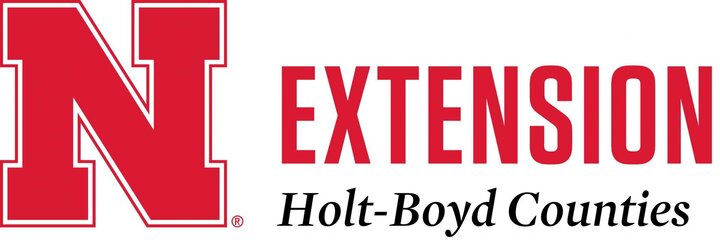
Nebraska Extension Educator - Holt & Boyd Counties - LaDonna Werth
Nebraska Extension Educator - Holt & Boyd Counties - Amy Timmerman
Nebraska Extension Educator - Holt, Boyd, Garfield, Loup, & Wheeler Counties - Bethany Johnston
Nebraska Extension Educator - Brown, Rock, & Keya Paha Counties - Brittany Spieker
Nebraska 4-H Assistant - Holt & Boyd Counties - Debra Walnofer
August 22–September 1: Nebraska State Fair, Grand Island, NE
September 13-14: Nebraska State 4-H Shotgun Championships, 8am-6pm, Heartland Public Shooting Park, Alda, NE; For more information: https://sites.google.com/view/nestateshotgun/home
October 1: ServSafe Manager Training, 8:30am - 6pm, Hall County Extension Office, Grand Island, NE
October 1: Knowing, Growing, and Grazing Grass Registration Deadline, Register at: go.unl.edu/knowing_grass
October 4: Nebraska 4-H Shooting Sports Instructor Initial Workshop, 8am–6pm, Panhandle Research Extension Center, Scottsbluff, NE
October 4: Nebraska 4-H Shooting Sports Instructor Update Workshop, 9am–12pm, Panhandle Research Extension Center, Scottsbluff, NE
October 5: Nebraska 4-H Shooting Sports Instructor Initial Workshop, 8am–12pm, Panhandle Research Extension Center, Scottsbluff, NE
Oct 11-12: Nebraska 4-H Shooting Sports Instructor Update, 9am–12pm, Ashland Gun Club, Ashland, NE
Oct 11-12: Nebraska 4-H Shooting Sports Instructor Training, 8am – 6pm, Ashland Gun Club, Ashland, NE
October 13-30: Knowing, Growing, and Grazing Grass Webinar Series, Monday and Thursday evenings, 7:30pm - 8:45pm CT, go.unl.edu/knowing_grass
Tips for Families to Cook Healthy, Eat Right, and Stay Active
Planning meals ahead of time can improve health while saving time and money. Involving children in meal planning and cooking offers unique benefits, from building essential life skills to fostering family connections. Check out these tips to help cook healthy, eat right, and stay active as a family.
Get Kids Involved in Cooking
When kids help out in the kitchen, they develop valuable cooking skills and learn about food safety while improving their nutrition knowledge. Cooking with children also supports math, reading, and science skills, along with fine motor development. It's a chance for family bonding and fun, leading to more successful mealtime experiences.
Age-Appropriate Kitchen Tasks:
- Ages 3-5: Use cookie cutters, wash fruits and vegetables under running water, mix simple ingredients, clear tabletops, and use pieces of food to craft fun shapes.
- Ages 6-7: Crack eggs in a bowl, deseed peppers and tomatoes, stir ingredients, and prepare lettuce for salads.
- Ages 8-9: Use a can opener, beat eggs, measure and mix dry ingredients, use a vegetable peeler, and use a food thermometer.
LaDonna Werth
Extension Educator
Phone: 402-336-2760
E-mail: lwerth2@unl.edu

- Ages 10-12: Boil pasta, simmer ingredients on the stove, follow simple step-by-step recipes, slice or chop vegetables, and safely use microwave and oven.
Practice Food Safety
It is important to not forget about food safety basics when preparing food. Follow these guidelines:
- Wash hands with soap and water before and after handling food.
- Clean countertops and cooking surfaces prior to cooking.
- Use clean utensils.
- Ensure children avoid tasting food before it's fully cooked.
- Pull back long hair.
- Always supervise children in the kitchen to prevent accidents.
Eat Right and Stay Active
Healthy nutrition and physical activity are both crucial for children. Be mindful of eating away from home, portion sizes, types of beverages consumed (especially those high in added sugars), and meal patterns and frequency. Physical activity is equally important. Kids should aim for at least 60 minutes of movement daily, engaging in fun and varied activities appropriate for their age.
By planning meals, getting children involved in cooking, and encouraging healthy habits, families can enjoy meals together while supporting children’s health and well-being.
Source: Fit and Healthy Kids
Corn Disease Pressure Builds in Nebraska
Diseases are common and severe in some Nebraska corn fields this year. The sustained high relative humidity, abundant rainfall in some areas, and warm temperatures have been very favorable for numerous pathogens - especially fungi and some bacteria. Some parts of the state have or are experiencing record levels of southern rust (again). With cooler weather just around the corner, we should see southern rust slow, but tar spot could become more active, bringing more questions about what to expect in Nebraska corn fields.
With the rapid increase in southern rust in some fields lately, many are considering late fungicide applications, and sometimes second applications. However, based on the collective body of university data reported by the Crop Protection Network, fungicide applications are generally not recommended for corn in the dent (R5) stage because of the decreased probability of economic return - this is particularly true for second applications (Table 1). Historically, late-season fungicide applications have occasionally led to a yield increase in field experiments under more extreme conditions, such as in susceptible, late-planted corn under heavy disease pressure.
Given that the window of protection provided by most contemporary foliar fungicides is about three weeks, if a second fungicide treatment is needed, it should be made three weeks following the first application to provide maximum benefits. Second applications are less likely to provide an economic return except in the case of heavy disease pressure.
Amy Timmerman
Extension Educator
Phone: 402-336-2760
E-mail: atimmerman2@unl.edu

Black Spots
Changing weather conditions over the next several days may bring some relief from southern rust in parts of Nebraska, but cooler temperatures will likely favor more tar spot development and spread. Late during the crop season, it is also common for the rust fungi (causing both southern rust and common rust) to begin producing black pigmented teliospores instead of the more common and recognizable orange/tan urediniospores . Teliospores are produced on or near the old rust pustules and often in a ring or horseshoe shape around it. Their proximity to old rust pustules and shape are the best ways to differentiate them from the black stromata produced by the tar spot fungus, which are more pointed or diamond-shaped as they grow larger. Also, mature tar spot stromata should also have evidence of a black structure visible on both the upper and lower surfaces of the leaf.
Increased Risk for Stalk Rot Diseases and Stalk Lodging
There are several scenarios that could increase the risk for stalk rot diseases and lodging this year in some Nebraska corn fields. Development of substantial leaf diseases can inhibit plants’ ability to fill grain and lead to stalk cannibalization, which hollows out the stalk and weakens it.
Nutrient imbalances - such as nitrogen deficiencies that develop after heavy rainfall - leech nitrogen and can also lead to weakened stalks and several other crop stresses.
You can evaluate the risk for stalk lodging in each field by using a “push or pinch” test of >100 plants from different parts of the field and calculating the percent of those that lodge below the ear or are easily crushed by hand (in the lower internodes).
Prioritizing harvest of more vulnerable fields to be harvested first or earlier than normal if they have more than >10% of plants with weakened stalks can reduce harvest losses due to lodging later.
For More Information
If you see symptoms that look like tar spot on corn - especially in one of the counties where the disease hasn’t been confirmed in disease distribution maps - please reach out to someone in Nebraska Extension or send samples to the UNL Plant and Pest Diagnostic Clinic.
The tar spot fungus will continue to overwinter in Nebraska corn fields and disease will redevelop and continue to spread. Most fields have very minor disease with no impact on yield. Eventually, as the fungal inoculum builds in corn fields over time and disease becomes more severe, it may become a threat to yield in more areas and require active disease management to minimize and prevent economic losses to producers. Thus, it is important that we continue to monitor spread of the pathogen to new areas of the state so that local producers and those in the ag industry can be alerted.
Please see CropWatch and the Crop Protection Network for more information.
Submit samples to the UNL Plant and Pest Diagnostic Clinic and enclose a completed sample submission form.
Source: Tamra Jackson - Ziems - Extension Plant Pathologist (CropWatch - August 22, 2025)
Challenges Of the Beef Calf Born In July, August, And September
While there are advantages to having a late summer/fall born beef cattle herd, there are challenges to be addressed just as with a spring born herd.
Heat and the Baby Calf
While summer/fall calving can be less labor intensive than winter/spring calving at times, calving out cows in the heat can be just as challenging as calving in a snowstorm. The body weight of a baby calf is about 75% water, similar to a human baby. Therefore, dehydration is a serious concern. A two-day old baby calf enduring the second day of 100-degree ambient temperature is likely experiencing some dehydration. These calves often cannot reach the water tank and may need to be administered electrolytes. A stressed calf can quickly become an ill calf who then experiences an elevated body temperature from a fever in addition to stressful ambient temperatures. An 85-degree day with 30 percent relative humidity may seem nice to humans, but it starts to cause heat stress in cattle.
A shady area with some air flow specifically for the calves can reduce heat stress potential in a young calf. A very young calf struggling with the heat may need to be manually moved to a cooler area. Just as a calf born in the cold may have to be moved to a house or barn to recover from the cold, a calf suffering heat stress will also benefit from a few hours in a cooler environment and fluids.
Bethany Johnston
Extension Educator
Phone: 402-336-2760
E-mail: bjohnston3@unl.edu

Cattle Work vs. Farm Work
Just like spring born calves, summer/fall born calves also need to be on a proper vaccination schedule. This typically happens at 2 months of age and at 5 or 6 months of age. If the operation is an integrated operation with crops and livestock, or both a spring and fall born herd, this can also be a very busy time for other farming and ranching operations. Planning out a schedule and prioritizing calfhood vaccinations can alleviate a lot of issues later in the calf’s life and increase the market value of the calves when sold.
Nutrition Quality and the Growing Calf
There are many reasons producers decide to have a summer/fall calving herd and many positive outcomes to those decisions. However, depending on the region of the country the cowherd resides in, fall and winter feed resources may be very low in quality. The young nursing calf will generally eat approximately 1.5% BW on a dry matter basis of feed in addition to milk consumption. When forage quality is low, passage rate is slow, and intake is reduced. This reduces the nutrients available to the calf and can result in lower average daily gain than would be expected in a spring born herd grazing summer grass.
Additionally, the poorer quality forage can impact milk production in the cow, also reducing the nutrients available to the calf. A supplementation program for the cows can help meet their nutrient needs. Accounting for the intake of the calf and providing that with the dam’s feed or providing a creep area for calves to access feed independently of the cow can improve the nutrient intake of the calf.
From Summer’s Heat to Winter’s Arctic Blast
The fall born calf may only be three months old when the snow starts to fly, and the windchills hit subzero temperatures. Windbreaks and bedding for the pairs can keep the calves from being extremely stressed during these winter events. Increasing the feed provided during cold snaps can increase the heat of fermentation in the rumen, and an increase in energy density in the diet can help combat the colder temperatures.
Summer/fall calving herds can be advantageous for producers with the right resources and marketing strategies. However, as with all agricultural endeavors, there are pros and cons. Evaluating what issues might arise and developing risk mitigation strategies ahead of time can head off many problems before they arise.
Source: Karla Wilke - Nebraska Extension Cow/Calf Systems and Stocker Management Specialist (BeefWatch - August 1, 2025)